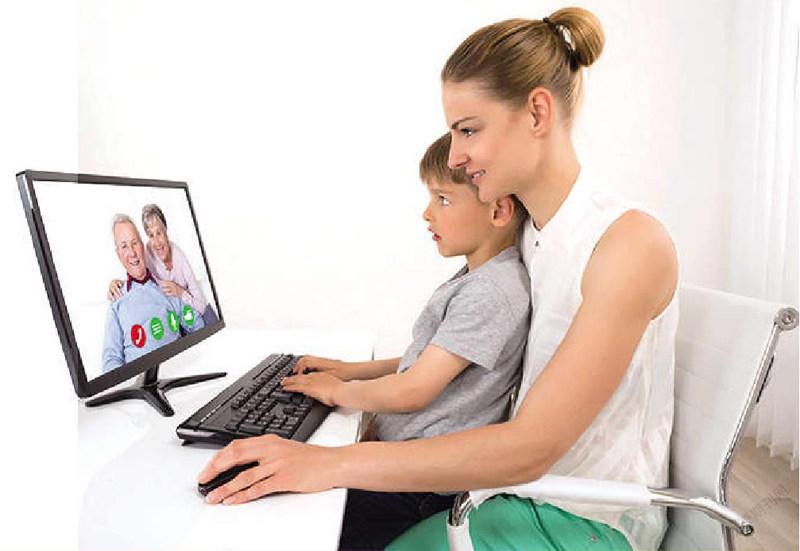Driving K-12 Innovation:2022 TECH ENABLERS(Ⅰ)譯題 基礎教育創(chuàng)新驅動力報告——2022技術驅動篇(一)

Product by CoSN (The Consortium for School Network)美國學校網絡聯(lián)合會
《基礎教育創(chuàng)新驅動力報告》是繼《地平線報告(基礎教育版)》后推出的國際教育信息化發(fā)展的重要參考報告,報告發(fā)布方美國學校網絡聯(lián)合會(CoSN)為《地平線報告》發(fā)布方美國新媒體聯(lián)盟的原有合作伙伴,致力于為基礎教育及學前領域的教育技術從業(yè)者提供團隊、知識和專業(yè)發(fā)展服務,助力創(chuàng)建和發(fā)展更有吸引力的學習環(huán)境。
2022 TOP 3 TECH ENABLERS
DIGITAL COLLABORATION ENVIRONMENTS
Digital systems, tools, technologies, connectivity, and pedagogy that enable high levels of collaboration and support on line and in-person learning. Digital Collaboration Environments include both synchronous and asynchronous communication tools — platforms that allow multi-user, virtual communications, whether across the room or across the globe. These environments may be tailor-made for education but are often designed for broader use (for example, video call technologies).
UNTETHERED BROADBAND & CONNECTIVITY
Ubiquitous broadband Internet and the underlying technologies that enable robust connected learning – without requiring devices to be physically connected (via cables, for example). These technologies enable mobility and learning anytime, anywhere.
ANALYTICS & ADAPTIVE TECHNOLOGIES
Open digital technologies that collect and use data related to teaching and learning. Analytics refers to the process of analyzing data collected about student learning and the opportunity to leverage data to inform instructional decision making. Adaptive technologies are tools that adapt to the student based on their interactions with the technology. These adaptations could be in the form of suggesting next steps, providing remediation, controlling pacing, or providing feedback based on analysis of the student's performance.
ENABLER
DIGITAL COLLABORATION ENVIRONMENTS
Digital Collaboration Environments have now topped our Advisory Board’s top Tech Enablers list for three years in a row. This long-standing run as a top Tech Enabler reflects how these environments flexibly support teaching and learning and their power to enable agility as schools shift between in-class, remote, and hybrid learning models.
Before the pandemic, there was a long period of growth of alternative learning models that relied on digital platforms. This allowed the use of Digital Collaboration Environments to balloon during the pandemic, as education systems around the globe scrambled to rapidly transition to hybrid or remote learning.
But in order to unleash the full power of these environments, we must focus on collaboration and optimize the experience in the environments. For example, some educators are expanding collaborative scenario-based learning and speculative storytelling using the built-in whiteboard features. Effective collaboration allows educators to facilitate feedback loops, increase engagement, leverage peer interdependence to increase performance, build social skills, and promote higher-level thinking.
These powerful Digital Collaboration Environments will grow evermore essential as the state of the world grows evermore unpredictable.
“When moving to a hybrid or online model, we traveled back in time and used the traditional methods in our online environments, neglecting the methodological innovations. Let’s think ahead and be prepared for any future scenario, not just considering the actual school, but what we think the future of learning will be.”( David Vidal, Seville, Spain)
TIPS & RECOMMENDATIONS FROM THE ADVISORY BOARD
THINK FORWARD FOR YOUR STUDENTS’ FUTURE
“Lean into the future by adopting mindsets and collaborative practices that will build the future-ready learning environments our students need to thrive and face their world with future-facing ideas, knowledge and skills” (Mary Lang, Los Angeles County Office of Education, California, U.S.).
IT’S NOT ABOUT “IN-PERSON” VS.“ONLINE” — IT’S ABOUT LEARNING
“Create experiences for students ... go beyond the text/workbook/small group learning” (Michael Lambert, True North School, Hanoi, Vietnam).
STAY FOCUSED ON IMPACTFUL USES OF TECHNOLOGY
Advisory Board Member Kate Crawford (Fayette County Public Schools, Georgia, U.S.) is concerned about a loss of innovative instructional gains made by teachers during the shift to virtual, which could result from criticism that technology is now being overused. She recommends avoiding “throwing the baby out with the bathwater” and taking a closer look at how the tools and resources are being utilized.
SHIFT MINDSET FROM “GO LIVE” TO “GO ANYWHERE”
Partnering more closely with your IT team will allow you to move deeply into the full user adoption and optimization journey.
譯文
2022年排名前三的技術驅動
數字協(xié)作環(huán)境
數字系統(tǒng)、工具、技術、連接性和教學法,可實現高水平的協(xié)作并支持在線和面授學習。數字協(xié)作環(huán)境包括同步和異步通信工具,這些平臺允許在一個房間內或全球范圍內的多用戶協(xié)作和虛擬通信。這些環(huán)境看似是為教育量身定制的,但通常是為更廣泛的用途而設計(例如視頻通話技術)。
不受限制的寬帶和網絡連接
無處不在的寬帶互聯(lián)網和底層技術為學習提供“無限”的網絡連接,甚至無需物理連接設備(例如網線),這些技術讓隨時隨地學習成為可能。
分析和自適應技術
開放數字技術指收集和使用與教學和學習相關的數據技術。分析技術是指分析有關學生學習數據的過程,以及利用數據為教學決策提供信息的可能性。自適應技術是根據學生與技術的交互而適應學習的工具或技術。這些技術的應用可以為學生提供學習建議、補救方案,從而有效控制學習節(jié)奏,或依據學生的表現,分析并提供及時反饋等。
技術驅動
數字協(xié)作環(huán)境
數字協(xié)作環(huán)境已連續(xù)三年被咨詢委員會推選為技術驅動應用的榜首。這反映了數字協(xié)作環(huán)境作為首要技術驅動,長期在支持教師的教與學生的學方面具有很高的靈活性,在傳統(tǒng)課堂、遠程教學和混合學習模式間也具有極強的轉換能力。
在新冠肺炎疫情暴發(fā)之前,基于數字平臺的輔助學習模式已經在持續(xù)地增長。這使得數字協(xié)作環(huán)境的應用在疫情期間激增,因為全球教育系統(tǒng)必須迅速地從線下教學過渡到混合或遠程學習模式。
但為了釋放數字協(xié)作環(huán)境的全部力量,我們必須專注于師生協(xié)作,并優(yōu)化環(huán)境使用中的用戶體驗。例如,有些教育工作者正在使用內置的白板功能擴展基于場景的協(xié)作學習和啟發(fā)性故事的講述。有效的協(xié)作能促進教育工作者的反饋頻次,增加參與度,利用同伴相互激勵來提高績效,培養(yǎng)社交技能并促進更高層次的思維能力。
隨著世界狀況變得越來越不可預測,強大的數字協(xié)作環(huán)境將變得越來越重要。
“當轉向混合或在線學習模式時,我們似乎在在線環(huán)境中繼續(xù)使用傳統(tǒng)課堂上使用的方法,而忽略了教學方法的創(chuàng)新。當我們提前設想未來課堂方案并做好準備時,不僅要考慮當下的教學任務,還要考慮未來的學習情況。”(David Vidal,西班牙塞維利亞)
咨詢委員會的提示和建議
為學習者的未來著想
“我們要采用面向未來的思維方式和協(xié)作實踐來構建面向未來的學習環(huán)境,因為學習者需要掌握面向未來世界的理念、知識和技能。”(Mary Lang,洛杉磯縣教育辦公室,美國加利福尼亞州)
不是關于“面授”或“在線”——而是關于學習
“為學習者等創(chuàng)造超越文本或課堂筆記或小組學習的真實體驗!”(Michael Lambert, True North School,越南河內)
持續(xù)關注技術的有效應用
咨詢委員會成員Kate Crawford(費耶特縣公立學校,美國喬治亞州)擔心當下對過度使用技術的批判會讓教師在向虛擬教學轉變過程中失去創(chuàng)新的教學成果。她認為,既要避免“把嬰兒和洗澡水一起倒掉”,也要仔細研究工具和資源的使用情況。
將思維從“上線”轉變?yōu)椤叭ト魏蔚胤健?/p>
與你的IT團隊更緊密地合作,能夠促進自己進一步融入深度用戶采用和創(chuàng)新應用之中。

